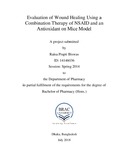| dc.contributor.advisor | Chowdhury, Fabliha Ahmed | |
| dc.contributor.author | Biswas, Raisa Prapti | |
| dc.date.accessioned | 2018-11-14T04:35:35Z | |
| dc.date.available | 2018-11-14T04:35:35Z | |
| dc.date.copyright | 2018 | |
| dc.date.issued | 2018-07 | |
| dc.identifier.other | ID 14146036 | |
| dc.identifier.uri | http://hdl.handle.net/10361/10842 | |
| dc.description | This project report is submitted in partial fulfilment of the requirements for the degree of Bachelor of Pharmacy, 2018. | en_US |
| dc.description | Catalogued from PDF version of project report. | |
| dc.description | Includes bibliographical references (page 86-91). | |
| dc.description.abstract | Skin is the first line of defence mechanism in our body. When the protective barrier of skin breaks we can define it as a wound. Wounds need to be healed very fast in order to restore body’s normal defence mechanism. For healing purpose different cell types and multiple steps are involved. Wound healing mechanism contains three main phases which are inflammation phase, proliferation phase and regeneration phase. In inflammation phase macrophage and neutrophils works, in proliferation phase, several growth factors like TGF (Transforming Growth Factor)-beta1, EGF (Epithelial Growth Factor), VEGF (Vascular Endothelial Growth Factor) etc and finally in regeneration, reconstitution of skin occurs. There are several drugs used for wound healing but all those need a longer time period for wound recovery. Along with that they have several side effects too. To minimize these side effects and to make the wound healing faster we came up with a combination therapy. We have used mice models for this experiment. Wound was created on the back of the mice and medicines were administered intraperitoneally (IP). There were four groups of mice. One group is treated only with saline, another one with Diclofenac-Na, next one with the antioxidant Vitamin C and last one with a combination therapy of Diclofenac-Na and Vitamin C. For determining the effect on inflammation phase did WBC counting, for proliferation we did quantification of VEGF and for regeneration we measured wound closure and weight of skin. The result of the study shows that for WBC counting the combination therapy has shown the most effective value. In quantitative analysis of VEGF also the combination therapy has shown better result than the monotherapies. But in this test, Vitamin C has shown better result than Diclofenac-Na and the concentration of VEGF was higher in earlier stage on day 2, 4 and 7. Finally, for regeneration phase we have measured the wound closure. In this case also combination therapy showed most effective result. Healing rate was faster on day 7 and 9. For regeneration, we did weight variation test. In that case also combination has shown better result amongst all. From all these results it has come to a conclusion that combination therapy has shown better result in wound healing. So, we can consider this combination therapy as an alternative medication for wound healing although this needs further investigation. | en_US |
| dc.description.statementofresponsibility | Raisa Prapti Biswas | |
| dc.format.extent | 91 pages | |
| dc.language.iso | en | en_US |
| dc.publisher | BRAC University | en_US |
| dc.rights | BRAC University project reports are protected by copyright. They may be viewed from this source for any purpose, but reproduction or distribution in any format is prohibited without written permission. | |
| dc.subject | Wound healing | en_US |
| dc.subject | NSAID | en_US |
| dc.subject | Antioxidant | en_US |
| dc.subject | Mice model | en_US |
| dc.subject.lcsh | Wound healing. | |
| dc.subject.lcsh | Humans -- Pain -- Drug therapy | |
| dc.title | Evaluation of wound healing using a combination therapy of NSAID and an antioxidant on mice model | en_US |
| dc.type | Project report | en_US |
| dc.contributor.department | Department of Pharmacy, BRAC University | |
| dc.description.degree | B. Pharmacy | |

